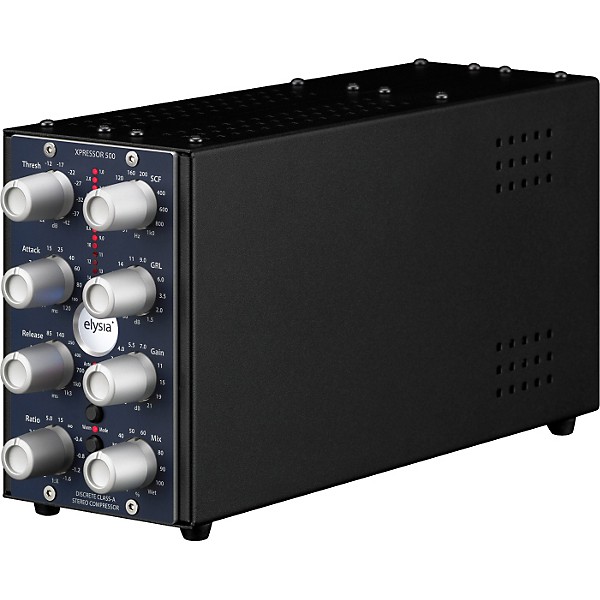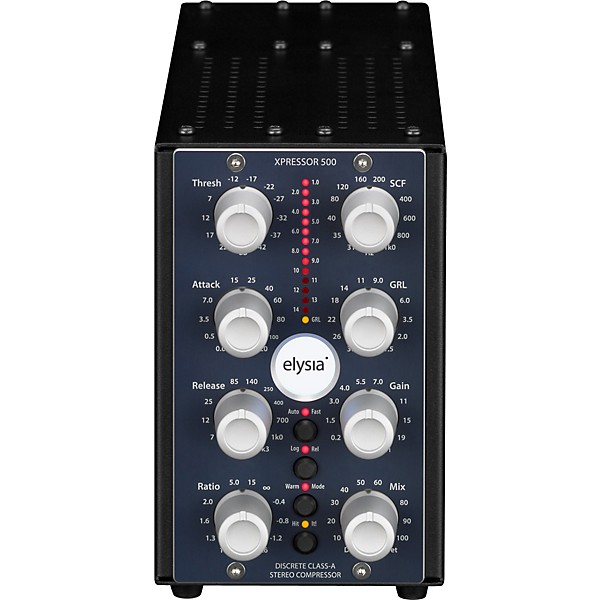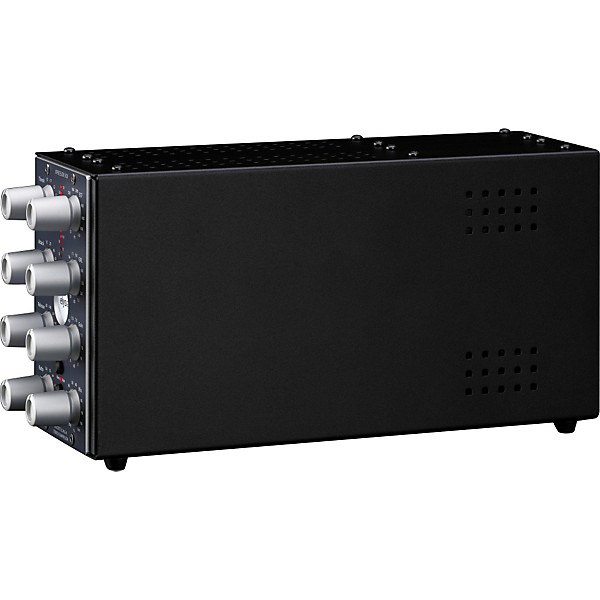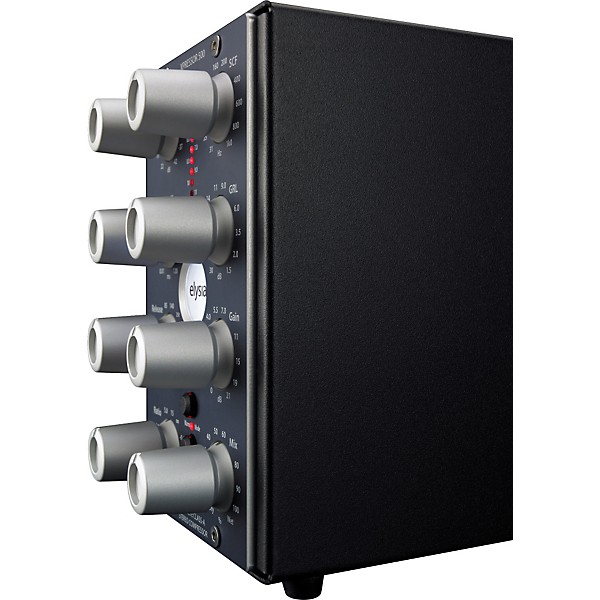Gear SpecialistBundlingMusician
Get exclusive savings on top brands like Gibson, Fender® and Epiphone when you call 866-498-7882 or chat
Elysia xpressor 500 Stereo compressor available in API 500 series format
$999.00
6-month special financing^ + $99 back in Rewards** Limited time Learn More
Lease-To-Own Purchase OptionsLearn more
Save on orders $199+ and get expert advice from a Gear Adviser
Need Help?

 Description
Description
The elysia xpressor 500 is an extremely versatile stereo compressor available in 500-series format. With its many unique features taken from Elysia's flagship products, you not only get great compression, but an amount of control on processing which is hardly ever experienced elsewhere.
No matter if you want set-and-forget, or to delve deep into the secrets of compression, the xpressor 500 is for you. Its discrete audio path running in constant class-A mode provides superior audio quality, which combines a clear and open sound with a lot of punch.
Stereo bus compression, processing single signals, approaching dynamics in creative ways - the xpressor 500 shines in all applications.
Discrete Class A Topology
A true elysia specialty, the audio path of the xpressor 500 is completely based on discrete circuitry and does not use any integrated circuits at all to color the signal path. Its entire audio path is a new design based on the exclusive use of high-grade discrete components. A truly unique recipe. In addition, it operates in permanent class A mode. This means that the transistors are always conductive, resulting in the absence of crossover distortion, providing a pristine sonic base; the general sound character is always wide, open and punchy.
Auto Fast
Inspired by Elysia's flagship compressors: Auto Fast enables you to set the perfect attack. It's a switchable, semi-automated attack based on the value you set by ear. However, sometimes one setting doesn't always work based on changes in the program material. For example, if a very short attack time is chosen, the compressor can catch the short peaks, but the sustaining signal will also be processed, which might result in audible distortion. Longer settings reduce distortion significantly, but then the compressor is set too slow for catching fast impulses. That's where Auto Fast comes in: For example, if you set the attack to 80ms and then engage the Auto Fast mode, the attack time will be shortened automatically on fast and loud signal impulses. The compressor reduces the signal quickly and prevents it from slipping through. Afterward, the attack time automatically returns to its original setting. In Auto Fast mode the compressor can be very fast, but only when it is really needed. This function influences the attack parameter on short and loud impulses only; in all other cases the original setting of the controller has priority.
Log Release
This alternative characteristic of the release curve follows a logarithmic course instead of the standard linear function, resulting in a very gentle compression. Since it's difficult to achieve perfect results on different material with only one type of release curve, the xpressor 500 offers two different options to chose from: logarithmic and linear.
In logarithmic release mode, the time constant shortens when the amount of gain reduction increases. The advantage is that short and loud peaks (e.g. drums) have a fast release time, while the remaining material is processed with a slower release. Its smooth performance makes the Log Release especially useful for mastering and stereo bus compression.
The linear mode has a straight release profile; without the slower tapering release characteristic of the Log mode. The linear mode is a good choice for more aggressive dynamics control of dry signals, and it is especially useful when you want to process signals that do not have a long decay period.
Negative Ratios
The characteristic curve bends and goes back down-heavy pumping, backward sounds, etc.-perfect for very cool compression effects.
Negative ratios-what exactly does that mean? To get a better understanding of this function, it makes sense to understand what the ratio control of a ˜normal' compressor does:
¢ 1:1 - The signal remains linear, there is no compression going on.
¢ 1:2 - After crossing the threshold, an increase of 2dB at the input will be compressed to an increase of 1dB at the output.
¢ 1:ˆž - After crossing the threshold, the output signal is constantly held at the threshold level without reacting to further increases at the input (limiter).
At a negative ratio, the characteristic curve bends and returns back down after crossing the threshold. The louder the input signal, the lower the output signal-perfect for groovy compression effects. To get a grip on the extreme "destruction" this can cause, engaging the Gain Reduction Limiter is just the right idea.
Beyond infinity - made possible by the xpressor 500
Parallel Compression
Available directly on the unit: the direct and the compressed signal can be blended in any desired relation by simply turning the mix controller.
Parallel compression, also known as "New York" compression, is a technique based on mixing a dry signal with a heavily compressed identical signal. It maintains the subtleties of a performance while stabilizing the dynamics.
The mix controller of the xpressor 500 makes it possible to crossfade between the unprocessed and the compressed signals. This allows parallel compression right in the box and eliminates additional routing for better signal quality.
Now you can use even extreme compression settings without killing a track by winning the loudness war. By mixing just a part of the compressed signal to the original, the major portion of the initial dynamic structure remains intact.
Sidechain Filter
A tunable low cut filter in the sidechain of the xpressor 500 avoids over-compression and pumping when there is a lot of low-end energy in the mix.
The xpressor 500 has a selectable-frequency low-cut filter located in the sidechain. This means that it will not affect the audio signal itself, but the way in which it will be compressed. The key phrase here is "frequency selective compression."
Let's say you are processing a mix that has a very prominent kick drum. If you used the traditional approach of full range compression, you'd probably end up over-compressing the mix. The reason for this is the great amount of low-end energy the kick produces, causing high amounts of gain reduction on the entire mix. And what makes it even worse, is that your mix can start to pulsate in the beat of the kick-cool for some electronic music, but certainly not always welcome.
The low-cut filter of the xpressor 500 reduces the influence that low frequencies have on overall compression-a very easy way to apply the desired amount of gain reduction without the side effect of the track starting to pump.
This technique is especially useful in mastering, or compressing a mix before mastering. Plus, it can also be a handy tool for processing subgroups or even single signals too.
Gain Reduction Limiter
A specialty of the xpressor 500 is the Gain Reduction Limiter for the control voltage. This limiter is not placed in the audio path where you would usually find it, but in the control path of the compressor. When it is activated, it limits the control voltage according to the setting of the GR Limit controller. This means that no matter how high the input level might become, the amount of gain reduction will never exceed the value you've set.
By way of example, imagine a fader on a mixing console with your hand riding the fader to "play compressor." If the fader was limited by a piece of duct tape at -10 dB, for example, it could only reduce the signal up to this value. If the input level dropped below this limit, the fader would be moved up correspondingly.
However, if the input signal got even louder, the fader could not be moved down any further because of the duct tape limit, and then the output signal would become louder again in correspondence with the input signal. This way, loud parts in an arrangement keep their dynamics, since they will not be compressed beyond the limit of the Gain Reduction Limiter. Some very nice special effects like ducking or upward compression can be easily achieved with this, by only reducing the quieter parts without changing the original dynamics.
Warm Mode
The xpressor 500 offers a second switchable sound flavor by altering its frequency spectrum, harmonics, and transient response.
This function is basically a slew-rate limiter that reduces the speed of the output amplifier stages. This affects the frequency spectrum, the harmonics, and transient response at the same time.
Fast transients are slowed down a bit and the overall sound appears more round and merged. As this function influences the behavior of the output stages, the effect it creates has an impact on the complete processing results of all EQ stages.
In this way the xpressor 500 offers two different sound characters at the push of a button: the powerful transparency of the discrete class-A circuitry and the saturated richness of the Warm mode.
Analog Dynamic LED Meter
The gain-reduction meter modulates its LEDs in their brightness in order to show the action of the compressor in an analog way: fast, with smooth transitions.
In addition to what your ears tell you, the gain-reduction meter is a very important visual tool for evaluating the operation of the compressor. A lot of devices make use of more-or-less precise VU meters. But because of the inertia of the needle, these meters are only useful with moderate time parameters.
Another popular form of meter is the LED chain. Unfortunately it has a disadvantage, too: When the standard driver units are used, the change between two values always happens abruptly. A single LED in the chain can therefore only show an imprecise value in a defined interval. Frenetic flicker indicates that the actual value must be somewhere in between.
The xpressor 500 solves these problems by using a dynamic analog variant that combines the benefits of both VU meters and LED chains. This meter is based on LEDs too, but a special circuit design makes it possible to show intermediate values by modulating the brightness of the LEDs.
This means a true analog way of showing the operation of the compressor: very fast, but with smooth transitions. The user gets an important tool for precise gain reduction monitoring-finally the relationship between acoustic and visual perception feels just right.
Stepped Potentiometers
All potentiometers in the xpressor 500 have 41 steps that are a great help for recalling your previous sessions fast and precisely. They also provide a useful range of possible settings-and you'll just love the feel of them.
*Note: In order to operate, 500-series units require a VPR**-compliant power suppy, or "lunchbox" such as the Radial Workhorse (#H74107), A Designs Audio 500HR Rackmount Frame (#241582), or Empirical Labs EL 500 (#H72812).
** What is the VPR Alliance?
Initiated by API Audio, the VPR Alliance is a program of standardization and consistency guidelines for manufacturers wishing to make products designed to fit into API's 500 series rack format. The program provides complete design specifications for manufacturers interested in producing third party products that physically fit and electronically conform to API's rack specifications.
The creation of the VPR Alliance has been encouraged by the overwhelming popularity of API's 500 series racks, including the ten-space 500VPR and the six-space lunchbox, which has led to a proliferation of third party modules to fit the API format. Typically installed into API racks, these third party modules have raised issues of warranty and interaction with API-manufactured modules in the same rack.
Because of the variables related to those third party modules, API has previously been forced to declare that including third-party modules into a 500VPR or lunchbox simply voids the warranty of the API rack. Through the VPR Alliance, API is able to eliminate confusion as to which third party products void the API warranty and which do not. This straightforward resolution saves the company both time and money, and promotes goodwill to customers.
Customers benefit from the VPR Alliance through the elimination of any confusion as to which products are endorsed for placement in API racks. Customers also benefit from a wider range of module choices for their racks, safety in the knowledge that the specification of the third party unit is correct, and that there is no risk of damage occurring.
No matter if you want set-and-forget, or to delve deep into the secrets of compression, the xpressor 500 is for you. Its discrete audio path running in constant class-A mode provides superior audio quality, which combines a clear and open sound with a lot of punch.
Stereo bus compression, processing single signals, approaching dynamics in creative ways - the xpressor 500 shines in all applications.
Discrete Class A Topology
A true elysia specialty, the audio path of the xpressor 500 is completely based on discrete circuitry and does not use any integrated circuits at all to color the signal path. Its entire audio path is a new design based on the exclusive use of high-grade discrete components. A truly unique recipe. In addition, it operates in permanent class A mode. This means that the transistors are always conductive, resulting in the absence of crossover distortion, providing a pristine sonic base; the general sound character is always wide, open and punchy.
Auto Fast
Inspired by Elysia's flagship compressors: Auto Fast enables you to set the perfect attack. It's a switchable, semi-automated attack based on the value you set by ear. However, sometimes one setting doesn't always work based on changes in the program material. For example, if a very short attack time is chosen, the compressor can catch the short peaks, but the sustaining signal will also be processed, which might result in audible distortion. Longer settings reduce distortion significantly, but then the compressor is set too slow for catching fast impulses. That's where Auto Fast comes in: For example, if you set the attack to 80ms and then engage the Auto Fast mode, the attack time will be shortened automatically on fast and loud signal impulses. The compressor reduces the signal quickly and prevents it from slipping through. Afterward, the attack time automatically returns to its original setting. In Auto Fast mode the compressor can be very fast, but only when it is really needed. This function influences the attack parameter on short and loud impulses only; in all other cases the original setting of the controller has priority.
Log Release
This alternative characteristic of the release curve follows a logarithmic course instead of the standard linear function, resulting in a very gentle compression. Since it's difficult to achieve perfect results on different material with only one type of release curve, the xpressor 500 offers two different options to chose from: logarithmic and linear.
In logarithmic release mode, the time constant shortens when the amount of gain reduction increases. The advantage is that short and loud peaks (e.g. drums) have a fast release time, while the remaining material is processed with a slower release. Its smooth performance makes the Log Release especially useful for mastering and stereo bus compression.
The linear mode has a straight release profile; without the slower tapering release characteristic of the Log mode. The linear mode is a good choice for more aggressive dynamics control of dry signals, and it is especially useful when you want to process signals that do not have a long decay period.
Negative Ratios
The characteristic curve bends and goes back down-heavy pumping, backward sounds, etc.-perfect for very cool compression effects.
Negative ratios-what exactly does that mean? To get a better understanding of this function, it makes sense to understand what the ratio control of a ˜normal' compressor does:
¢ 1:1 - The signal remains linear, there is no compression going on.
¢ 1:2 - After crossing the threshold, an increase of 2dB at the input will be compressed to an increase of 1dB at the output.
¢ 1:ˆž - After crossing the threshold, the output signal is constantly held at the threshold level without reacting to further increases at the input (limiter).
At a negative ratio, the characteristic curve bends and returns back down after crossing the threshold. The louder the input signal, the lower the output signal-perfect for groovy compression effects. To get a grip on the extreme "destruction" this can cause, engaging the Gain Reduction Limiter is just the right idea.
Beyond infinity - made possible by the xpressor 500
Parallel Compression
Available directly on the unit: the direct and the compressed signal can be blended in any desired relation by simply turning the mix controller.
Parallel compression, also known as "New York" compression, is a technique based on mixing a dry signal with a heavily compressed identical signal. It maintains the subtleties of a performance while stabilizing the dynamics.
The mix controller of the xpressor 500 makes it possible to crossfade between the unprocessed and the compressed signals. This allows parallel compression right in the box and eliminates additional routing for better signal quality.
Now you can use even extreme compression settings without killing a track by winning the loudness war. By mixing just a part of the compressed signal to the original, the major portion of the initial dynamic structure remains intact.
Sidechain Filter
A tunable low cut filter in the sidechain of the xpressor 500 avoids over-compression and pumping when there is a lot of low-end energy in the mix.
The xpressor 500 has a selectable-frequency low-cut filter located in the sidechain. This means that it will not affect the audio signal itself, but the way in which it will be compressed. The key phrase here is "frequency selective compression."
Let's say you are processing a mix that has a very prominent kick drum. If you used the traditional approach of full range compression, you'd probably end up over-compressing the mix. The reason for this is the great amount of low-end energy the kick produces, causing high amounts of gain reduction on the entire mix. And what makes it even worse, is that your mix can start to pulsate in the beat of the kick-cool for some electronic music, but certainly not always welcome.
The low-cut filter of the xpressor 500 reduces the influence that low frequencies have on overall compression-a very easy way to apply the desired amount of gain reduction without the side effect of the track starting to pump.
This technique is especially useful in mastering, or compressing a mix before mastering. Plus, it can also be a handy tool for processing subgroups or even single signals too.
Gain Reduction Limiter
A specialty of the xpressor 500 is the Gain Reduction Limiter for the control voltage. This limiter is not placed in the audio path where you would usually find it, but in the control path of the compressor. When it is activated, it limits the control voltage according to the setting of the GR Limit controller. This means that no matter how high the input level might become, the amount of gain reduction will never exceed the value you've set.
By way of example, imagine a fader on a mixing console with your hand riding the fader to "play compressor." If the fader was limited by a piece of duct tape at -10 dB, for example, it could only reduce the signal up to this value. If the input level dropped below this limit, the fader would be moved up correspondingly.
However, if the input signal got even louder, the fader could not be moved down any further because of the duct tape limit, and then the output signal would become louder again in correspondence with the input signal. This way, loud parts in an arrangement keep their dynamics, since they will not be compressed beyond the limit of the Gain Reduction Limiter. Some very nice special effects like ducking or upward compression can be easily achieved with this, by only reducing the quieter parts without changing the original dynamics.
Warm Mode
The xpressor 500 offers a second switchable sound flavor by altering its frequency spectrum, harmonics, and transient response.
This function is basically a slew-rate limiter that reduces the speed of the output amplifier stages. This affects the frequency spectrum, the harmonics, and transient response at the same time.
Fast transients are slowed down a bit and the overall sound appears more round and merged. As this function influences the behavior of the output stages, the effect it creates has an impact on the complete processing results of all EQ stages.
In this way the xpressor 500 offers two different sound characters at the push of a button: the powerful transparency of the discrete class-A circuitry and the saturated richness of the Warm mode.
Analog Dynamic LED Meter
The gain-reduction meter modulates its LEDs in their brightness in order to show the action of the compressor in an analog way: fast, with smooth transitions.
In addition to what your ears tell you, the gain-reduction meter is a very important visual tool for evaluating the operation of the compressor. A lot of devices make use of more-or-less precise VU meters. But because of the inertia of the needle, these meters are only useful with moderate time parameters.
Another popular form of meter is the LED chain. Unfortunately it has a disadvantage, too: When the standard driver units are used, the change between two values always happens abruptly. A single LED in the chain can therefore only show an imprecise value in a defined interval. Frenetic flicker indicates that the actual value must be somewhere in between.
The xpressor 500 solves these problems by using a dynamic analog variant that combines the benefits of both VU meters and LED chains. This meter is based on LEDs too, but a special circuit design makes it possible to show intermediate values by modulating the brightness of the LEDs.
This means a true analog way of showing the operation of the compressor: very fast, but with smooth transitions. The user gets an important tool for precise gain reduction monitoring-finally the relationship between acoustic and visual perception feels just right.
Stepped Potentiometers
All potentiometers in the xpressor 500 have 41 steps that are a great help for recalling your previous sessions fast and precisely. They also provide a useful range of possible settings-and you'll just love the feel of them.
*Note: In order to operate, 500-series units require a VPR**-compliant power suppy, or "lunchbox" such as the Radial Workhorse (#H74107), A Designs Audio 500HR Rackmount Frame (#241582), or Empirical Labs EL 500 (#H72812).
** What is the VPR Alliance?
Initiated by API Audio, the VPR Alliance is a program of standardization and consistency guidelines for manufacturers wishing to make products designed to fit into API's 500 series rack format. The program provides complete design specifications for manufacturers interested in producing third party products that physically fit and electronically conform to API's rack specifications.
The creation of the VPR Alliance has been encouraged by the overwhelming popularity of API's 500 series racks, including the ten-space 500VPR and the six-space lunchbox, which has led to a proliferation of third party modules to fit the API format. Typically installed into API racks, these third party modules have raised issues of warranty and interaction with API-manufactured modules in the same rack.
Because of the variables related to those third party modules, API has previously been forced to declare that including third-party modules into a 500VPR or lunchbox simply voids the warranty of the API rack. Through the VPR Alliance, API is able to eliminate confusion as to which third party products void the API warranty and which do not. This straightforward resolution saves the company both time and money, and promotes goodwill to customers.
Customers benefit from the VPR Alliance through the elimination of any confusion as to which products are endorsed for placement in API racks. Customers also benefit from a wider range of module choices for their racks, safety in the knowledge that the specification of the third party unit is correct, and that there is no risk of damage occurring.
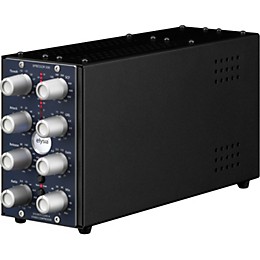
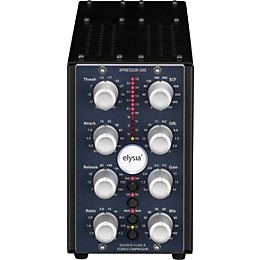
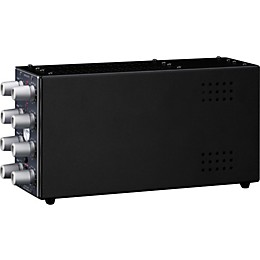
 Features
Features
- Discrete Class-A Topology
- Pristine audio quality
- Auto fast-attack; perfect attack in any situation.
- Switchable release characteristic; smooth or crisp - the choice is yours.
- Warm mode; transparency? Saturation? Both!
- Parallel compression; mixing direct and compressed signals.
- Sidechain filter
- Frequency-selective compression.
- Gain reduction limiter; ultimate control of compression
- Made in Germany with high-grade components and solid aluminum knobs
 Specs
Specs
- Frequency response: <10 Hz - 400 kHz (-3.0 dB)
- THD+N:
- @ 0 dBu, 20 Hz - 22 kHz, Mix 0%: 0.002 %
- @ 0 dBu, 20 Hz - 22 kHz, Mix 100%: 0.006 %
- @ +10 dBu, 20 Hz - 22 kHz, Mix 0%: 0.003 %
- @ +10 dBu, 20 Hz - 22 kHz, Mix 100%: 0.056 %
- Noise floor:
- 20 Hz - 20 kHz
- -94 dBu
- Dynamic range:
- 20 Hz - 22 kHz
- 115dB
- Maximum level:
- Input
- Output
- +21 dBu
- +21 dBu
- Impedance:
- Input
- Output
- 10 kOhm
- 68 Ohm
 Reviews
Reviews
Be the first to review the Product
 Q&A
Q&A
Have a question about this product? Our expert Gear Advisers have the answers.
No results but…
You can be the first to ask a new question.
It may be Answered within 48 hours.

